
Grand Isle was hit badly by Hurricane Ida. The are slowly coming back on line but it will not be done quickly. A start has been made.
In the days immediately after Hurricane Ida, several feet of sand and water trapped anyone who was still on Grand Isle after the Category 4 storm devastated Louisiana’s last inhabited barrier island. Island native and resident Richard Augustin visited three times shortly after the storm to assess the damage. “The first day it was like I was in awe. Then the next few times, it was heartbreaking,” he recalled as he lounged across the street from his house with his brother and friends. Now, two and a half months later, Augustin is watching his hometown start its slow but steady recovery. Ida’s footprint is still fresh. Piles of sand sit in empty lots, waiting to be placed back on the beach once trash and rubble are sifted out. Flattened houses have yet to be hauled away, and other missing walls or roofs await demolishment. Metal siding lies crumpled in ditches and open fields.
nola.com
It is a start and nothing more. It will require much work but first the people must be able to live there.
But progress has been made. About half of the island, including Augustin’s house, has had running water restored with a temporary line running from Lafourche Parish, though it isn’t drinkable. Repairs continue on the town’s main water line, running 35 miles north to Lafitte. On Monday, the community of Chenier, located just over the Andy P. Valence Memorial Bridge, also saw the return of running water. Grand Isle Mayor David Camardelle and Town Councilman Brian Barthelemy said officials hope to see water return to the whole island within two weeks, once all the system’s leaks are found. “Once we get these leaks taken care of, we’re about to put the lines to full capacity, pressure up the line of water for the people that can take water,” Barthelemy said. Even when water access ramps up, the low pressure means a boil water advisory will remain in effect. And while power has also returned to about 90% of the island, with nearly every electrical pole replaced, the area’s lines are hooked up to smaller, temporary generation plants as the substations that would normally send electricity to the town are still damaged.
Power, as we can remember the black out we suffered after Ida, power is essential.
But the return of power meant Augustin could finally come home more than a month and a half after the storm. Without a source of drinking water, Augustin and other returning residents now frequent an area, nicknamed “the store,” that houses donated items brought in by nonprofits. He’s also relied on his brother, Jack, to bring him gallons of distilled water. Despite the challenges, Augustin, who was born and raised on the island, said he’s a “lifer.” “I’m never gonna leave,” he said. “You know, if it comes it comes to the point it demolishes that house, I’ll be living in a tent. Or I’ll build me some kind of shack somehow or another, but I’m coming back.” Fellow resident Rick Howard, who returned soon after Ida despite the lack of power, said, “Once you get to the sand in your toes, … once you take your shoes off, you’ll be back.”
These two are not alone and they remind me of a Park Ranger I met at the Hatteras beaches who was born on them, worked on them and will die on them.
They said most full-time residents feel the same way. Barthelemy estimated that 60% have returned so far, and the town is working with the Federal Emergency Management Administration to provide temporary housing with trailers to allow the rest to come back. So far, there are about 40 trailers on Grand Isle, with 15 of those available for use. Officials are working on getting the rest hooked up to the grid. “We want them back here,” the councilman said. “We don’t want them to get displaced anywhere else.” Camardelle added: “When you put a mother and a child next to their home, it gives them hope.” But questions remain about what will happen next hurricane season. Ida leveled much of the 13-foot high “burrito” levee that offered a critical first line of defense again storm surge. In the state coastal authority’s October board meeting, officials said hard conversations were needed to determine what type of hurricane protection was needed moving forward and whether the likely prohibitive cost would be worth keeping the barrier island inhabitable.
To remain living there, work does have to be done to “fortify” the island.
Locally, Camardelle and Jefferson Parish Councilman Ricky Templet are pushing for breakwater rocks to be included in any plan moving forward, confident in their ability to sustain the island’s beaches over the long term. Sand and dunes, they said, are not enough. Augustin and Howard agreed, adding that they were also open to a seawall similar to the 17-foot-tall concrete structure that protects Galveston, Texas. “Rocks (are) the answer,” Camardelle said. “If the (Army) Corps (of Engineers) is coming in with a design with just sand, don’t come. … We don’t want to go to Congress every six months. Put some money where it’s going to work so we can focus on something else.” Templet added: “We’re spending millions, federal government-wise, upon millions to protection the green frog habitat … it’s time we’re spending millions and millions to protect our habitat.”
The question is should a beach be a fortification and what will be lost?



